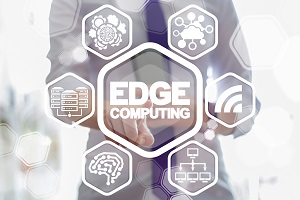Much like contemporary society and conceptions of the Internet of Things, notions of edge computing have considerably evolved in the relatively short amount of time since this term emerged at the end of the past decade.
Once, it was almost exclusively used to denote IoT endpoint devices continuously transmitting data and, as opposed to sending all of this data to a central location for analysis or processing, warranted performing some of these computations themselves before transferring the results to centralized settings.
That definition took on considerably greater latitude with the arrival of edge gateway devices which, according to DH2i CTO OJ Ngo, are responsible for serving as an intermediary between headquarter clouds and endpoint devices for many of the same tasks.
“To utilize an edge device you have to install an agent on that device,” Ngo mentioned. “The agent is required for the device to be useful. Now, what happens if you don’t have the means to install the agent on the edge device? Well, the next best thing is to have an edge gateway, so then all the devices that don’t have the agent can still do the work through the gateway.”
The use cases for this expression of the IoT represent some of the most vital and urgent applications of this phenomenon today. They range from a pragmatic means of decentralizing the computational workloads for sophisticated machine learning tasks—effectively forming a distributed supercomputer—to simply leveraging phones, tablets, and laptops for the current imperatives of remote communication.
In all instances, however, the IoT and its edge are only as utilitarian as they are secure, reliable, and ultimately, resilient. Today’s reliance on videoconferencing, distance education, and remote user access for enterprise resources becomes impossible (or worthless) if transmissions fail or are intercepted by malefactors.
Ensuring secure, ongoing connectivity is more meaningful than ever because of the dearth of alternatives for communicating with others, and may provide the premier challenge of the day.
As remote access demands increase “the IoT systems will be more edge-centric, not only in terms of the number of devices, but also some of the sophistication of what [is needed to] provision them, monitor them, get visibility into them, and be alerted proactively when things have changed,” explained Todd Rychecky, Opengear VP of Sales, Americas.
Edge Essentials
Remote access is at the fore of the networking necessities for edge deployments. Preserving the continuity of the network for mission critical data transmissions like videoconferencing lectures for distance education programs, for example, requires accounting for a host of hardware and software. “New technology and IoT devices gives us better digital experiences than before, but they also make the networks more complex,” Rychecky acknowledged. “You know, routers; you’ve got switches, firewalls; you’ve got sensors and cameras and video, and they’re all sitting at the edge of the network.” Remote access solutions can provision these components across the network to maintain resiliency via a basic edge paradigm involving numerous gateway devices distributing these resources for end users, coupled with monitoring and oversight capabilities in a centralized cloud.
This model enables IT teams to remotely supervise and provision resources from anywhere, receive and act on alerts about performance, and facilitate failovers to preserve connectivity. Without it, edge users must wait for personnel to travel to their respective gateways and troubleshoot each aspect of the network to alleviate latency or failure—which creates significant downtime. “Today we’re all sort of quarantined and we’re practicing social distancing,” Rychecky reflected. “People, organizations, and schools that don’t have remote access, they suffer downtime, which is a loss of business and in the case of corporations, it results in layoffs.”
Securing the Edge
Equally vital to provisioning network resources at the edge is addressing the assortment of cyber security issues inherent in edge deployments and the IoT in general. The surplus of problems plaguing common videoconferencing options involving GoTo Meeting, Zoom, and others also includes security concerns—which are redoubled for implementing these options in regulated verticals like healthcare for telemedicine deployments, for example. These concerns are predicated on the fact that endpoint devices rarely have the hardware and software capabilities of on-premise infrastructure to match the security of the latter, are outside of traditional perimeter defenses, and are usually designed for lightweight data transmissions, as opposed to enterprise security measures. Most video conferencing and Virtual Private Network (perhaps the most common cyber security method) solutions are positioned between data transmissions, making these third-parties privy to sensitive data in regulated verticals.
Software defined perimeters, however, issue discreet data transmissions directly between IoT applications “to build a secure tunnel between their smart devices back to their datacenter, or the cloud, or both,” remarked DH2i CEO Don Boxley. Alternatives to this method usually decrypt then re-encrypt data—before sending transmissions between people in videoconferences, for example—which could “potentially provide a backdoor where your conference is being eavesdropped by somebody else,” Boxley said. “It would be like a wiretap, if you will.” However, the enhanced, obfuscated UDP tunnels of credible software defined perimeters and their DTLS encryption deliver end-to-end protection since “there is nobody in the middle, so nobody can tap that pipe,” Boxley commented. “It’s essentially invisible to the outside world.”
Edge Processing
As previously identified, the crux of edge computing is for devices at the extremity of the IoT to process data locally before issuing results to a central location for integration or aggregation. This use case is distinct from simply managing the edge of a network or the devices involved in it, and is characterized by Ngo as “small devices carrying out a distributed workload and combining many of them together to do a bigger task.” Edge computing is crucial for any sort of distributed analytics and substantially reduces the bandwidth of the amount of data traversing a network.
Thus, when relying on Wi-Fi, for example, IoT transmissions monopolizing a network’s bandwidth “can lock up, slow down, and get gummed down” Rychecky revealed. Edge processing decreases the likelihood of such occurrences; more progressive organizations leverage it to decentralize computations for statistical AI deployments via this paradigm for use cases involving facial recognition, for example. Additional influences on edge processing and most IoT deployments include:
- Microservices: According to Ngo, microservices “is about taking an app or a service and making it isolated. The best way to do so is to put it in a container because then you can quickly and easily deploy from any host.” Most sophisticated IoT (and cloud) apps leverage microservices.
- Containers: These lightweight, logical repositories are immensely portable, making them optimal for edge deployments. “When microservices is deployed in containers you get two things,” Ngo maintained. “First is ease of deployment…there’s no major effort or labor cost when deploying containers. Second is the availability and flexibility of where you can deploy your containers.”
- Isolated Security: By deploying IoT apps in containers, “you give the customer or user a means of isolating a workload and providing a higher level of security,” Ngo said. “Running things inside of a container, you tie things down and it doesn’t give access to the rest of your infrastructure.”
Broadening the Edge
Reliance on edge components and edge processing is becoming more critical to the decentralized big data landscape, especially with the ongoing need to communicate remotely. Current healthcare events are responsible for increasingly driving such forms of communication to include professional and personal spheres of life. As such, it’s imperative to ensure edge networks can be remotely provisioned, secured, and available for fringe processing where applicable to continue to support what’s become a burgeoning need for the IoT in general. Therefore, security and availability of these networks “is very important in providing access to [IoT] services and requirements, now and into the foreseeable future,” Rychecky acknowledged.
About the Author

Jelani Harper is an editorial consultant servicing the information technology market. He specializes in data-driven applications focused on semantic technologies, data governance and analytics.
Sign up for the free insideBIGDATA newsletter.





Speak Your Mind